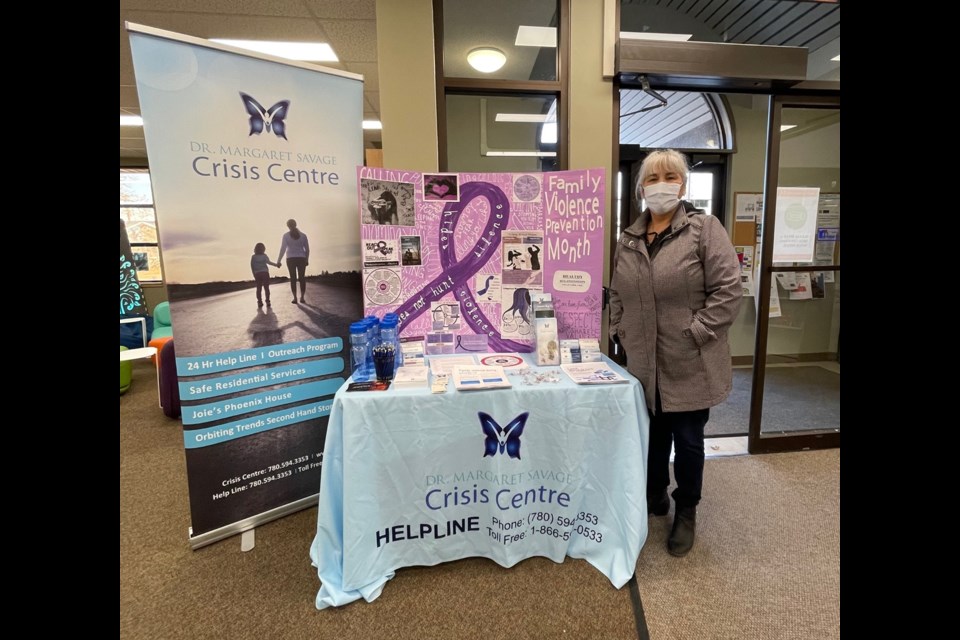BONNYVILLE – Throughout November the Dr. Margaret Savage Crisis Centre (DMSCC) has been hosting a series of traveling informational displays throughout the City of Cold Lake and the Town of Bonnyville to raise awareness during Family Violence Prevention Month.
On the evening of Nov. 18, DMSCC released a vigil video featuring messages of support and hope from RCMP Victim Services, Cold Lake Mayor Craig Copeland and others.
Every year the DMSCC holds a candlelight vigil for the victims of family violence and domestic violence, however, due to the pandemic the last two vigils have been moved online.
"We hope that the community will join us in lighting the candle to show their solidarity in honour of those impacted and continue to be impacted by family violence,” says Cindy Yang, the resource development and public education coordinator for DMSCC.
Yang and the centre’s outreach team provide businesses and organizations with public education on family violence, intimate partner violence, domestic violence, and shares information on the services DMSCC provides to women, families and seniors fleeing abuse.
“Both of our outreach teams in Cold Lake and in Bonnyville have worked hard on creating informational displays that are rotating in the community,” says Yang. "On those boards are some resources, information, things that people can take home with them.”
Yang explains “the hope and the aim of the (community information boards) are to build a little bit more public awareness to draw the attention to an issue that we experience right here in the Lakeland. Ultimately, it takes a community effort to support families and survivors of family violence and domestic violence.”
She adds that even if the information may not be applicable to someone's own experience, it can provide the tools to support people in their lives that might be facing abuse.
Shadow pandemic
Speaking to an unintended consequence of the pandemic and the public health measures imposed, Yang states, “We know from previous crises, like natural disasters in times of crisis, this increasing anxiety and external stressors worsen domestic violence situations.”
The DMSCC has had to regularly adapt to changing health measures as well as the ongoing challenges of the Centre's clientele.
“Due to the nature of the necessary public health measures with the pandemic, especially the stay-at-home measures, that created a double-edged sword and what is being dubbed as the shadow pandemic, meaning that domestic violence unfortunately, worldwide, was at an all-time high. This was caused in part to the stay-at-home measures which increase the time that victims and their perpetrators would spend together, and that creates a challenge,” says Yang.
Due to the unique challenges posed during the pandemic, staff at DMSCC have been exploring other avenues in creating public awareness and creating avenues for victims of domestic violence to be able to safely reach out.
“We realized that maybe leaving was not always the safest option or immediately possible because of the stay-at-home measures. So, we wanted to pivot some of our messaging and share with our community members to say shelters are more than just a bed,” she says. “We wanted to encourage people to reach out, to do safety planning with our crisis intervention workers so that they have a plan in place just in case they are ready to leave or in case anything escalates and they need that safety plan.”
Yang says throughout the pandemic the calls to the crisis line have risen compared to previous years. And although shelters have been required to reduce their capacity, she says housing and solutions are always found to help those needing support.
“Regardless of the public health measures and pandemic, women shelters remain the safest place for women fleeing violence,” she reiterates.
Public education
“As far as public education goes, we are really trying to show our community that this happens, this could happen to anybody, domestic violence and abuse does not discriminate,” says Yang.
Yang explains that domestic violence centers around power and control. Often abusers and perpetrators of violence are experts at manipulating that power and control over their victim. They can sometimes rely on positive outward image as well as rely on a sense of loyalty from others including the victim of the abuse.
“It's a very complex dynamic and that's why we think that public education is so important,” Yang says. “People might not understand truly to the extent of what is emotional abuse, for example. So, our outreach team has also been making these wonderful social media resources that we're sharing through the month of November that flush (signs of abuse) out a little bit more.”
Safety plan
Yang further explains the significance and purpose of a safety plan.
“Whenever the potential for violence is identified in woman's life, it's important to develop that safety plan and that involves identifying different action steps to prepare in advance for the possibility of further violence, because risk factors and abusive situations change quickly.”
A safety plan is a fluid document that can increase the safety of an individual and their independents whether they are living in an abusive relationship, thinking about leaving an abusive relationship or have already left an abuser.
Yang recommends including what an emergency escape looks like, photocopies of important documents, such as a driver's license, school records for children, prescriptions, bank statements, birth certificates, status cards, and phone numbers of places that can be accessed 24/7.
Yang says it is vital to keep a safety plan in a place where their perpetrator would not have access to it.
“It's like a cat and mouse dance – trying to provide (resources) to victims without compromising the methods of women trying to flee domestic violence,” she notes.
The Dr. Margaret Savage Crisis Centre’s 24/7 confidential Help Line can be reached at 780-594-3353
More information on the services provided by the shelter can be found at www.dmscc.ca



